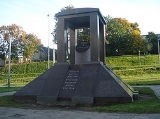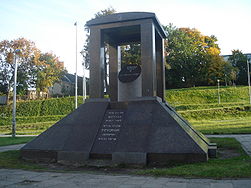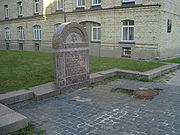
HKP 562 Slave Labor Camp
Encyclopedia

Vilnius
Vilnius is the capital of Lithuania, and its largest city, with a population of 560,190 as of 2010. It is the seat of the Vilnius city municipality and of the Vilnius district municipality. It is also the capital of Vilnius County...
, Lithuania
Lithuania
Lithuania , officially the Republic of Lithuania is a country in Northern Europe, the biggest of the three Baltic states. It is situated along the southeastern shore of the Baltic Sea, whereby to the west lie Sweden and Denmark...
, was the site of an unusual labor camp during the Holocaust
The Holocaust
The Holocaust , also known as the Shoah , was the genocide of approximately six million European Jews and millions of others during World War II, a programme of systematic state-sponsored murder by Nazi...
. The camp was officially owned and administered by the SS, but run on a day to day basis by a Wehrmacht
Wehrmacht
The Wehrmacht – from , to defend and , the might/power) were the unified armed forces of Nazi Germany from 1935 to 1945. It consisted of the Heer , the Kriegsmarine and the Luftwaffe .-Origin and use of the term:...
engineering unit, HKP 562 (Heereskraftfahrpark 562) stationed in Vilna. HKP 562's commanding officer Major Karl Plagge was sympathetic to the plight of his Jewish workers. Plagge and some of his men made efforts to protect the Jews of the camp from the murderous intent of the SS.
Establishment
The HKP camp was hastily erected in September 1943 when Major Plagge learned of the impending liquidation of the Vilna GhettoVilna Ghetto
The Vilna Ghetto or Vilnius Ghetto was a Jewish ghetto established by Nazi Germany in the city of Vilnius in the occupied Lithuanian Soviet Socialist Republic , during the Holocaust in World War II...
and with considerable difficulty gained permission to move his Jewish workers and their families to a free-standing labor camp on the outskirts of Vilna. The camp housed approximately 1,000 Jewish men, women and children. Due to the sympathies of Major Plagge, it was largely free of the abuse, hunger and brutality found in most slave labor camps in Nazi-occupied Poland. In spite of the generally benign attitude of the officers and men of the HKP unit, the SS did enter the camp on several occasions and committed atrocities. Most notable was the Kinder Aktion (an action against the camp's children) on March 27, 1944, during which the SS removed the vast majority of the 250 children living in the camp, who were then taken to their deaths.
Liquidation

Ponary massacre
The Ponary massacre was the mass-murder of 100,000 people, mostly Polish Jews, by German SD and SS and Lithuanian Nazi collaborators Sonderkommando collaborators...
and shot. Over the next three days the SS searched the camp and its surroundings and succeeded in finding half the missing prisoners; these 250 Jews were shot in the camp courtyard. However, when the Red Army captured Vilnius a few days later, some 250 of the camp's Jews emerged from hiding. This group represents the largest single group of Jewish survivors of the Holocaust in Vilnius.

